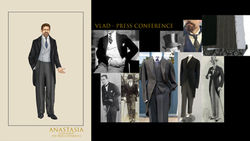
MELISSA THURN
COSTUME DESIGNER & ILLUSTRATOR


MT
ANASTASIA (THEORETICAL 2021)
The plot of Anastasia revolves around a legend that the Russian Grand Duchess Anastasia Nikolaevna managed to escape the execution of her family in 1918, and creates an alternate history where she survives to find happiness. The musical is an adaptation of the 20th Century Fox 1997 animated film of the same name, and while it keeps six songs from the movie, it completely removes the film’s supernatural elements in support of a more realistic retelling of the legend.
The show is set across three distinct time periods. The prologue covers the years, 1906 and 1917, relaying the demise of the Russian Imperial family. The rest of the show occurs in 1927. The amnesiac “Anya,” (who unknowingly is Anastasia and cannot remember her past) hopes to find a sense of family, belonging, and identity. She teams up with con-men Dmitry and Vlad, who wish to take advantage of her likeness to the rumored living Anastasia, in order to obtain the monetary reward from her exiled grandmother Dowager Empress Maria Feodorovna in Paris. Meanwhile, the conflicted Soviet Deputy Commissioner Gleb Vaganov, torn between his sense of duty to his country and his father – as well as his growing fondness for Anya -- seeks to end the Romanov line once and for all.
My costume design concept depicts the characters in period appropriate garments based on location and social standing while honoring the animated character design of the film. Act I features the Romanov family and their court mirroring the actual 1903 winter fancy dress ball which celebrated the 290th anniversary of the Romanov dynasty and was regarded Europe’s last great royal ball. These costumes are influenced by the 17th century style costumes designed by Sergey Solomko that were heavily adorned and bejeweled. They featured grandiose headdresses and hats that borrowed historic pieces from the imperial armory. By featuring these characters in these extremely opulent and historic costumes, it further conveys how “out of touch” the royalty and nobility were from the starving and suffering public. The remainder of Act I takes place in winter Russia and mostly concerns the workings of lower-class people. Their garments are more worn and dated in predominantly earth tones. This stands in stark contrast to Act II’s springtime in Paris, where the early 1930s high fashion influenced looks are bright, luxurious, and stylish.

PROLOGUE - 1906 & 1917
 |  |  |
|---|---|---|
 |  |  |
 |  |














































